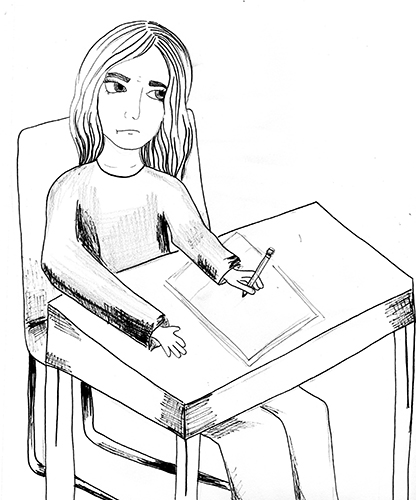Academic Dishonesty Policy requires communication
Discrepancies between courses call for clarification between teacher and student

illustration by Raya Shoilekova
February 9, 2018
His sophomore English teacher passes around a sheet with scenarios of academic dishonesty. As the teacher reads through each scenario, John* thinks to himself: I’ve done that dozens of times, how is that academic dishonesty? The scenario John reads describes a student unsure about his paper’s content, and his friend offers suggestions. Innocent enough… Right?
The Board of Education of District 225’s Academic Dishonesty Policy states “academic dishonesty by students degrades character and reputation and impedes individual learning.” While this message is clearly communicated, the Oracle Editorial Board believes teachers’ individual policies can sometimes conflict with one another and leave students feeling unsure of the proper behaviors.
The Editorial Board commends the efforts of teachers and the administration to provide clarity. However, we believe that there are still improvements to be made in the explanation and application of the policy.
Students
Each of our classes come with varying policies regarding collaboration on a teacher-by-teacher basis. Regardless of these differences, it is the student’s responsibility to understand what is expected in each class.
According to Cameron Muir, Associate Principal for Curriculum and Instruction, academic dishonesty policies are left open-ended so teachers can apply them to their respective curriculums. Muir says the responsibility of understanding the policy falls on both student and teacher.
“The onus is a mutual communication piece,” Muir said. “We [as a system] communicate to every student, every single year, what our expectations are.”
Dr. Thomas Kucharski, instructional supervisor of the English Department, says it is also important that students are aware of what constitutes academic dishonesty, such as sharing Google Docs with peers. He advises that students clarify with their teacher if they are confused.
The Editorial Board believes that these policies are meant to benefit students by ensuring we grasp each skill. Taking collaboration with others too far will only be a disadvantage.
Senior Evan Holloman saw the benefits from his teacher’s implementation of the policy in his Project Lead the Way (PLTW) class during his freshman year. Holloman says that in contrast to his other classes, where dividers were placed to stop cheating, his teacher instead created a testing environment based on trust.
“The testing environment was so much more relaxed, and it allowed us to focus on our tests more,” Holloman said. “[My teacher] basically just counted on the honesty policy because if we were to cheat, the only person that we’d be hurting is ourselves.”
Despite there being the overarching district-wide Academic Dishonesty Policy, students should avoid confusion with a teacher’s intent for a specific assignment by reaching out.
Teachers
There are occasions where class expectations vary between teachers within the same course. While it is understandable that each has their own expectations, the Editorial Board recommends that teachers of the same course continue to communicate and work with others in their department on policies to best avoid confusion.
One area, for example, is peer editing. Ryan Kinsella, social studies teacher, explains there are assignments that make sense for students to collaborate, and others where it does not.
“I encourage [peer editing] in class and let students know [if it is acceptable to peer edit], but if it’s not something that makes sense for that assignment, then I like to make that very clear to the student as well,” Kinsella said. “The idea of collaboration is one that we need to talk about more explicitly in class so students understand what is taking, what is collaborating, what is sharing, etc.”
The Editorial Board encourages teachers to instruct students on proper ways to peer edit to avoid academic dishonesty and reap benefits.
English teacher Katie Hoover is one of many teachers that gives students a checklist outlining peer editing procedure. Ensuring that students receive such resources across all courses would help to avoid conflict.
“The school of editing is one a lot of students aren’t as familiar with,” Hoover said. “So [structured peer editing activities are] an attempt that many teachers in our department use to train students at what to look for in editing.”
Administration
The Editorial Board recognizes the many responsibilities of the administration, including writing and implementing the Academic Dishonesty Policy. According to Muir, there is a challenge in updating any district wide policy.
“[In the future] we can kind of figure out, how do we involve student voice and teacher voice [in revisions of the policy]?” Muir said. “And then it’s the multiple disciplines: how do we develop a policy that works for a written paper, a speech, a math homework assignment, a test?”
Given the need for greater communication, the Editorial Board suggests that the administration allows students to play a larger role in facilitating the policy. For example, a student advisory panel may allow students to voice concerns about the policy as they experience it in class. This panel could meet anywhere from an annual basis to every two years to ensure the policy progresses with the curriculum.
Principal Dr. Lauren Fagel says while the policy has its strengths, there is a lack of communication between teachers and its consistent application.
“School wide, we’re not there,” Fagel said. “From my perspective, if I asked ten different teachers about [the policy], you might get six different answers.”
The Oracle Editorial Board respects the Academic Dishonesty Policy and the role it plays in the classroom. We hope future communication between students, teachers and the administration can be streamlined to ensure that the policy is uniformly enforced from class to class.


